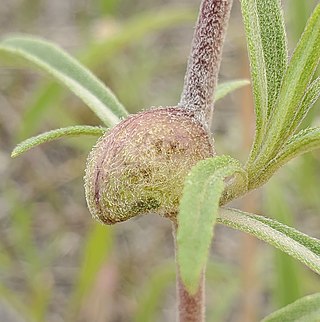
Cecidomyiidae is a family of flies known as gall midges or gall gnats. As the name implies, the larvae of most gall midges feed within plant tissue, creating abnormal plant growths called galls. Cecidomyiidae are very fragile small insects usually only 2–3 mm (0.079–0.118 in) in length; many are less than 1 mm (0.039 in) long. They are characterised by hairy wings, unusual in the order Diptera, and have long antennae. Some Cecidomyiids are also known for the strange phenomenon of paedogenesis in which the larval stage reproduces without maturing first. In some species, the daughter larvae consume the mother, while in others, reproduction occurs later on in the egg or pupa.

Aprostocetus is a genus of hymenopteran insects of the family Eulophidae. The genus was erected by John O. Westwood in 1833. This very large group of parasitoid wasps has a global distribution.

Creosote gall midges are a species of gall-inducing flies in the Asphondylia auripila group. This group consists of 15 closely related species of flies which inhabit creosote bush sensu lato. They have partitioned the plant ecologically with different gall midge species inhabiting the leaves, stems, buds, and flowers of creosote bush. Each species induces a uniquely shaped gall but the insects are otherwise morphologically very similar and very difficult to tell apart.

Borrichia frutescens is a North American species of flowering plants in the family Asteraceae known by the common names sea oxeye, sea oxeye daisy, bushy seaside tansy, and sea-marigold. In Veracruz it is called verdolaga de mar. It is native to the United States and Mexico, where it occurs along the Atlantic and Gulf Coasts. Its distribution extends from Maryland south to Florida and west to Texas in the US, and along the Mexican Gulf Coast to the Yucatán Peninsula. It is an introduced species in some areas, such as Bermuda and Spain.
Asphondylia neomexicana is a species of gall midges in the family Cecidomyiidae.

Asphondylia is a cosmopolitan genus of gall midges in the family Cecidomyiidae. All species in this genus induce galls on plants, especially on flowers and flower buds. There are over 300 described species in Asphondylia, with many more likely to be discovered and described, especially in the southern hemisphere.

Asphondyliini is a tribe of gall midges in the family Cecidomyiidae. There are about six genera and at least 100 described species in Asphondyliini.

Caryomyia is a genus of hickory gall midges in the family Cecidomyiidae. They are often known as the hickory gall midges since most species feed on various species of hickory. There are at least 30 described species in Caryomyia.
Neolasioptera is a genus of gall midges, insects in the family Cecidomyiidae. There are at least 130 described species in Neolasioptera.

Asphondylia helianthiglobulus is a species of gall midge in the family Cecidomyiidae. The larvae of this species induce galls on the stems of several sunflower species in eastern North America, including Helianthus giganteus,H. grosseserratus, and H. maximiliani.
Asphondylia lacinariae is a species of gall midges in the family Cecidomyiidae.

Asphondylia auripila is a species of gall midge in the family Cecidomyiidae. It forms galls on Larrea tridentata stems.
Asphondylia prosopidis, the mesquite gall midge, is a species of gall midges in the family Cecidomyiidae.

Asphondylia floccosa, the woolly stem gall midge, is a species of gall midges in the family Cecidomyiidae. The larvae induce galls on Atriplex polycarpa. They don't feed on the gall itself, but rather fungus that grows within the gall. Each gall can contain anywhere from one to fifteen chambers. This species is known from Arizona and California, and was first described by American entomologist Raymond Gagne in 1968.
Asphondylia ratibidae is a species of gall midges in the family Cecidomyiidae.

Asphondylia ceanothi, the ceanothus bud gall midge, is a species of gall midges in the family Cecidomyiidae.

Asphondylia solidaginis is a species of gall midge (Cecidomyiidae) that induces galls on goldenrods in North America where it is widespread. It was first described by William Beutenmuller in 1907.
Asphondylia monacha is a species of gall midges in the family Cecidomyiidae.
Asphondylia amaranthi is a species of gall midge in the family Cecidomyiidae.

Asphondylia photiniae, also known as the toyon fruit gall midge or toyon berry gall midge, is a species of midge that induces galls on the developing berries of the toyon bush in North America. Galled berries stay green and look somewhat warped. Each galled berry contains a single larva, which emerges in spring. This midge is known from the Californias, where native Heteromeles arbutifolia grows in relative abundance.












